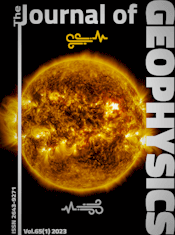The intercept-time method – possibilities and limitations
Article Sidebar

Vols. 1-18 (1924-1944), ISSN 0044-2801
Main Article Content
Abstract
In deep-seismic sounding the reflected and refracted waves recorded form a complex system of traveltime curves. The inverse seismic problem consists in determining the function ν (x, z) along the profile for a series of velocity levely ν (x, z) = const and discontinuities as well. This paper described a method which allows the transformation of observed traveltime curves into an intercept-time section with isolines of velocity. Such a section permits discrimination of the various types of waves and gives a qualitative picture of the crustal structure, and is then converted into a depth section. The application of this method is demonstrated by a number of examples from the Ukrainian Shield, the Tien Shan and the Caucasus showing both possibilities and restrictions.
 ARK: https://n2t.net/ark:/88439/y052591
ARK: https://n2t.net/ark:/88439/y052591
Permalink: https://geophysicsjournal.com/article/288
Article Details
References
Bamford, D. (1973) Refraction data in western Germany - a timeterm interpretation, J. Geophys. 39:907-927
Barthelmes, A.J. (1946) Application of continuous profiling to refraction shooting. Geophysics 11:24-42
Barry, K.M. (1967) Delay time and its application to refraction profile interpretation. In: Musgrave, A.W. (Ed.) Seismic refraction prospecting, Tulsa, Soc. of Epl. Geophysicists, 348-362
Bessanova, E.N., Fishman, V.M., Riaboyi, V.Z., Sitnikova, G.A. (1974) The r-method for inversion of travel times, I. Deep seismic sounding data, Geophys. J. R. Astr. Soc. 36:377-398
Červeny, V., Molotkov, I.A., Pšenčik, I. (1977) Ray method in seismology, Charles University Press, Prague
Fuchs, K., Muller, G. (1971) Computation of synthetic seismograms with the reflectivity method and comparison with observations, Geophys. J. R. Astr. Soc. 23:417-433
Gamburtsev, G.A., Riznichenko, Yu.V., Berzon, LS., Yepinatyeva, A.M., Pasechnik, J.P., Kosminskaya, J.P., Karns, E.V. (1939) Correlation method of refractions, Acad. Sci. USSR Press, Moscow 1952 (in Russian) Gardner, L.W.: An areal plan of mapping subsurface structure by refraction shooting Geophysics 4:247-259
Gardner, L.W. (1967) Refraction seismograph interpretation. In: Musgrave, A.W. (Ed.) Seismic refraction prospecting, Tulsa, Soc. Expl. Geophysicists, pp. 338-347
Giese, P. (1976) Depth calculation. In: Giese, P., Prodehl, C., Stein, A. (Eds.) Explosion seismology in Central Europe, Springer, Berlin 146-161
Hagedoorn, J.G. (1959) The plus-minus method of interpreting seismic refraction sections. Geophys. Prospecting 7:158-182
Hubral, P. (1977) Time migration - Some ray theoretical aspects. Geophys. Prospecting 25:739-745
Kondratiev, O.K., Gamburtsev, A.G. (1963) Seismic investigation in coastal part of Eastern Antartic. Nauka, Moscow
Konovalzev, J. (1980) The Donbass. In: Zverev, S.M., Kosminskaya, I.P. (Eds.) Seismic models of the main geostructures in the USSR territory. Nauka, Moscow (In Russian)
Matveeva, N.N. (1968) Computer algorithm and the method of velocity model determination. In: Problems of the dynamic theory of the seismic waves 9, Nauka, Leningrad (In Russian)
Oblogina, T.I. (1979) Two-dimensional problems. In: Inverse kinematic problems of explosion seismology, Nauka, Moscow, pp. 66-75 (In Russian)
Orcutt, I.A. (1980) Joint linear, extremal inversion of seismic kinematic data. J. Geophys. Res. 85:2649-2660
Pavlenkova, N.I. (1973) Interpretation of refracted waves by the reduced travel time curve method. Physics of the Solid Earth 8:544-550
Pavlenkova, N.I., Pšenčik, I. (1977) Mathematical modelling as a method of solving the two-dimensional seismic problem. Publ. Inst. Geophys. Pol. Acad. Sci., A-4(115):267-275
Pilipenko, V.N. (1979 ) Numerical time field method in the seismic interface construction. In: Inverse kinematic problems of explosion seismology, Nauka, Moscow, pp. 124-178 (In Russian)
Pšenčik, J. (1979) Ray amplitudes of compressional shear, and converted seismic body waves in 3 D laterally inhomogeneous media with curved interfaces. J. Geophys. 45:381-390
Puzirev, N.N., Krylov, S.V., Mishenkin, B.P. (1975) Methods of regional seismic investigations, Nauka, Novosibirsk (In Russian)
Riznichenko, Yu.V. (1946) Geometrical seismics of layered media, Trudy Inst. Teor. Geofiz., Vol. 2, Acad. Sci. USSR Press, Moscow (in Russian)
Romanov, M.E., Alekseev, A.S. (1980) A characteristic method for numerical solution of the inverse kinematic seismic problems. J. Geophys. 48:173-180
Shazilov, V.I. (1980) Tien-Shan. In: Zverev, S.M., Kosminskaja, I.P. (Ed.) Seismic models of the main geostructures in the USSR territory. Nauka, Moscow (In Russian)
Thornburgh, H.R. (1930) Wavefront diagrams in seismic interpretation. Bull. A.A.P.G. 14:185-200
Willmore, P.L., Bancroft, A.M. (1960) The time-term approach to refraction seismology. Geophys. J. R. Astr. Soc. 3:419-432
Wyrobek, S.M. (1956) Application of delay and intercept times in the interpretation of multilayer refraction time distance curves. Geophys. Prospecting 4:112-130











